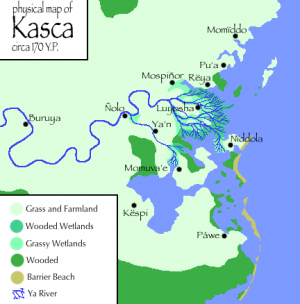Culture of Mɨdu
This page will contain discussions of the culture of the southern Fáralo states in the post-imperial period, with a focus on the largest and most influential city of Mɨdu.
The City
The city, inhabited since Ndak times, and also nearby an old Ngauro settlement, lies at the mouth of the slow Iłtsizɨme River (Fáralo Ilčizúəme, from an earlier Naidda form for "Black Water"). The immediate surroundings were swampy, but many of these were drained in Classical times, allowing the city to expand beyond the old walls. The main Etúgə temple lies on a squarish, artificial hill by the river, descending from a Ndak-era mound. Another such mound now forms a quarter known as the Dyeññał ("Little Hill"). The early Fáralo had maintained a large public plaza at the base of the temple hill, but more than half of this had been filled in by development by 500 YP. Concentric rings of canals radiate outward from this plaza, the innermost dating to Ndak times and with outer rings filled in by the Fáralo. During the Lewsfárah period an rectilinear western expansion of the city was planned, and the streets were laid, but the grid was never fully filled in by settlement, and overgrown fields came to occupy the outer edges of it. The massive ruins of an unfinished new temple may still be found in this vicinity.
To the Ndak this city was in an area of northern Kasca. This remained a cultural reality for many centuries, and indeed the city spoke a local dialect of Naidda. But Fáralo-ization began with the first conquest in -520 YP, and culminated in union with the Empire in -133. The last Naidda-speakers dwindled away by -50, though they remained significantly longer in the countryside. Furthermore, the loss of Naidda in the city was later supplemented by a large and fluid population of Delta Naidda-speaking merchants. Lewsfárah enshrined the local vernacular as a new spoken and written standard (by convention called "Southern Neo-Fáralo," SNF). Later Namɨdu does not derive precisely from this standard, which shows much dialect-mixing* and some artificial conservatisms, but from independent development of the vernacular. Nonetheless some usages are influenced by SNF.
The extent to which this old Naidda dialect came to influence the Fáralo spoken there is still under investigation; at least twenty distinctive vocabulary items have survived into Namɨdu.
*Most dramatic is the substitution of [θ] [ð] for Nam. [ʦ] [ʣ], which is a feature from Mæmedéi and Azbǽbu. In Namɨdu, loanwords with [θ] [ð] continue to be imported with [ʦ] [ʣ], for example Æðadĕ > Edzada.
The Calendar
The people of Mɨdu still follow the calendrical system they call the "Faraghin Week" (Horan Yati), with 8-day weeks. The names of the days have been imported directly from Fáralo, minus the definite article - except for the case of lu-Ubáz, where the lu- was joined to the root.
| Day | Fáralo | Namɨdu |
| 1 | lu-bewš | bes |
| 2 | lu-sos | sos |
| 3 | lu-ekúi | ekɨ |
| 4 | lu-geoč | gets |
| 5 | lu-baoluy | balɨ |
| 6 | lu-ubáz | luboz |
| 7 | lu-seošan | sesan |
| 8 | lu-lečew | lettse |
Sesan is usually a day off from work. The term ekɨ for the third day has Etúgə connotations; the Epɨm call it leps ("destruction") and get off work early and get drunk to celebrate past victories against Etúgə. Bes and balɨ are considered auspicious for performing ceremonies and business transactions. Lettse and sos are inherently unlucky - their effects are warded off, respectively, by painting household objects different colors, and having sex.
Religion
The chief competing faiths have been inherited from imperial times: Etúgə (Nam. Etugga) and Epɨmya; the latter being the religion of the Epɨm/Toło people, the spiritual cousins of the Puoni of Kuaguatia. But the religious situation in Mɨdu in 1100 YP is in flux, with a great number of people adhering to syncretic practices - though many of these would identify with one religion or the other.
Etúgə, the majority religion, ultimately has its root in Mûtsinamtsys and Takuña philosophy. It is evangelizing and strictly orthoprax, classifying all deeds of men into moral categories. As per the writings of the sage Sútapaj (F. Hutaba; Nam. Huppa), constant and meditative attention to the reality of moral actions as opposed to a posteriori knowledge will lead to an epiphany in which the believer enters an enlightened state that transcends corporeal being. The exact understanding of this has changed over the years; early writings tended to describe this epiphany like the Zen notion of satori, hitting the believer like a thunderbolt - today it is understood as a cumulative lifelong process.
An Etúgə temple is called a kuffas and its priest a kawu; Mûtsipsa' names were borrowed directly to emphasize the total split from pagan traditions. But the Epɨm, motivated by the same impulse, returned to the old terminology - their temple is called a byenyoło and the priest a rɨna.
The Epɨm are descended from the "infidel" political/religious rebels of the third century - the portion which was deported to Ussor enslaved. They were scattered in urban areas throughout the empire, and for a few generations practiced their faith in secret. Some eventually were freed, and slowly the establishment became more open to their religious practice, even as many remained as an urban slave class. During the Silver Age they developed into a recognized ethnic subgroup, tending towards certain niche professions, and establishing trust with their Etúgə neighbors. In the post-imperial period they began accepting converts, and have swelled in size in response to a weakening Etúgə. Their largest population today (excluding the Puoni, who are essentially separate) is in the city of Mɨdu, a third of the city's total population.
Epɨm can be recognized by the "Mark of Daodas," a bindi-like dot of blue dye worn on the forehead.
